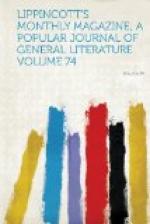With our minds full of these memories we set out on the morning after our arrival at Pallons, with Pastor Charpiot as guide, to explore the valley of Fressiniere and ascend to Dourmillouse. The immediate vicinity of Pallons is fair and fertile, but a short walk up the course of an impetuous torrent brought us to a narrow gorge, beyond which we found a totally different region. Bare slopes of rock that looked grim even in the sunny morning, and a waste valley-bottom, here of considerable width, but sterile and bleak, made up the landscape. Its dreariness was only increased by an occasional chalet standing beside a patch of limp and discolored potato-vines. As we went on the scene grew more and more gloomy. The tillage is in cleared spots not so large as the heaps of stones that surround them, or on bits of practicable soil left by land-slides in the midst of their hideous debris. The only trees are dwarfish pollards, reduced to bare trunks with thin tufts of green atop by the practice of stripping off the sprouts every two or three years to make fodder for the goats. Midway up the valley we passed the village of Violins. It seemed mournfully empty, and many of the houses were in reality deserted. A shy, bright-faced fellow opened the little temple for our inspection, and Pastor Charpiot reminded us how its interior was not only planned by Neff, but in large measure his actual handiwork. Half an hour further on our path led us through the hamlet of Minsas, now entirely abandoned and in ruins. The desolation of the valley here becomes appalling. On either hand sheer precipices of crumbling rock rise above steep slopes of gravel and loose stones. The ground is strewn thick with great boulders, many of which had left traces of their furious descent before settling, sometimes close beside the path, or even after crossing it in a final bound. The precipices from which they had detached themselves are composed of strangely-twisted strata, and frequently recurring streaks of lurid red give them a fierce and ghastly aspect. Landslips and torrents of stones are so frequent of late years that no more attempts are made to clear away the rubbish thus deposited. Where these scourges have not fallen the sullen stream has carried devastation. Floods occur every year. That of 1856 wrought a ruin from which the villages have never rallied. In the whole upper half of the valley of Fressiniere there is not, I suppose, an acre of land capable of cultivation. In the time of Neff, wretched as its condition must always have been, the poverty of this region was not so utterly hopeless as it has since become. The failure of all resources is literally driving away its inhabitants. Those who remain, as in such cases a certain proportion cannot help doing, sometimes in bad years pass three, six, and even nine, months without bread. Their small stock of potatoes is often exhausted long before it can be replenished. “I am at a loss,” said the pastor, “when we are no longer able to give them aid, to know how they live. The only semblance of food left to them is soup, for which, perhaps, they haven’t even salt, much less meat or vegetables. Turbid water—de l’eau trouble, rien de plus!”




